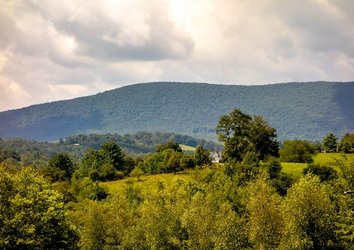Easily one of the iconic sounds of summer—right up there with lawnmowers and sprinklers—is the chirring drone of cicadas from the treetops. To many, it’s a refreshing, evocative sound, although some folks admittedly find it annoying—especially when the drone is a downright din, courtesy of the occasionally epic numbers these large, winged insects appear in.
Such major spikes in the cicada soundtrack are usually associated with the emergence of so-called periodical cicadas, which differ from the more commonly seen annual cicadas mainly by how much longer the periodical cicada youngsters—aka nymphs—spend sequestered away underground.
We’ll drill into this and other differences, and explain how a 2023 or 2024 trip to the Great Smoky Mountains might shake out, cicada-wise, below:
Cicadas: Love ‘Em or Hate ‘Em

Photo Credit by @startribune on Instagram
Found just about worldwide, cicadas belong to a vast insect order (Hemiptera) that also includes such members as bed bugs and aphids. You’ll sometimes hear people refer to them as “locusts,” but true locusts are grasshoppers, belonging to an entirely different insect order. The nomenclatural mixup appears to date back to the colonial era of North America when European settlers equated cicadas with locusts due to both insects often appearing in hordes.
As we’ve said, some people find the hissing cacophony of cicadas annoying. Others get the heebie-jeebies running across cicada “casts”: the lifeless husks left behind when a nymph transforms into a winged adult cicada.
But although exceptionally large emergences of cicadas may result in some tree damage (due to adult female cicadas inserting their eggs within the bark), these loud-voiced insects are entirely harmless to human beings—they don’t bite or sting whatsoever—and certainly unaggressive.
And both annual and periodical cicadas provide an essential food source for a whole host of Smoky Mountain critters, not least songbirds feeding nestlings and fattening up for migration, as well as a pulse of nutrients when their casts and dead bodies decay. They’re a fundamental part of the ecological fabric, in other words, and certainly, the cicada multitudes associated with periodical emergence years come heartily welcomed by local insect-eaters: from warblers to black bears.
Annual vs. Periodic Cicadas

Photo Credit by @hd_animals_lover on Instagram
There are many species of annual cicada native to the Southern Appalachian region, including southern grass cicadas, Walker’s cicadas, hieroglyphic cicadas, resonant cicadas, and northern dusk-singing cicadas (which happen to be the heftiest of all North American cicadas north of Mexico).
Annual cicadas, which tend to be larger than periodical cicadas live their lives on a shorter turnaround. Nymphs spend two years underground, and there are adults emerging every year (hence the name). Annual cicadas usually emerge in July and August—high summer, in other words, which explains another name for them: dog-day cicadas.
Periodical cicadas, by contrast—which are only found in North America, by the way—live for years as underground nymphs: either 13 or 17 years, to be exact. These 13- or 17-year periodical cicadas emerge all at once, a strategy that’s thought to have evolved to utterly overwhelm predators. After all those years slurping sap from tree roots underground, periodic cicada nymphs crawl into the sunshine in May—much earlier than those dog-day counterparts—and then metamorphose, in a few hours, into winged adults, leaving behind those rather alien-looking casts.
Male adult cicadas sing vigorously—and really, really loudly—in order to attract females for mating. With so many periodical cicadas fresh-emerged in a single area—and so much pressure to get some romantic business going on—their drone can be almost deafening, and audible for miles.
Periodical Cicada Emergences in the Smoky Mountain Area: Outlooks for 2023 and 2024

Photo Credit by @micchooooon on Instagram
There are multiple species each of 13- and 17-year periodical cicadas in eastern North America. Periodical cicadas that emerge in the same year, on the same timetable, are classified as broods. Some 30 broods of periodical cicadas are found in North America, and while the majority of 17-year broods are found in the Northeast and the majority of 13-year broods in the South, there’s definitely plenty of geographic overlap—including in the Smoky Mountains area.
In 2021, the largest of the 17-year broods, Brood X, emerged to much fanfare across a broad, disjointed range that included Tennessee and North Carolina.
The next big emergence year for periodical cicadas in the eastern U.S. is 2024 when two broods—the 17-year Brood XIII and the 13-year Brood XIX—will bust out simultaneously. Brood XIII is mainly expected in the Midwest, while Brood XIX is likely to appear farther south, including in the Smoky Mountain area.
As the website Cicada Safari (maintained by entomologist and noted cicada expert Dr. Gene Kritsky) notes, the dual emergence of these two particular broods only happens once every 221 years, the last time being in 1803!
Mainly only the usual, low-level appearance of annual cicadas in mid-to-late summer is expected in 2023, but it’s possible “early stragglers” of those two broods may pop up this year—a phenomenon the Cicada Safari website and app are trying to track with the help of citizen scientists, aka any and all observers.
The main event, though, will come next year, when a trip to the Great Smokies from mid-May into June might come enlivened by the forest-ringing chorus of periodical cicadas: one of the genuine natural wonders of eastern North America!
So keep an eye (and an ear) out next late spring and early summer, when you might get to combine a firsthand appreciation of a relatively rare major cicada emergence with enjoying the usual rhododendron and mountain-laurel blooms that so charm visitors to the Great Smoky Mountains that time of year. Pretty cool!




